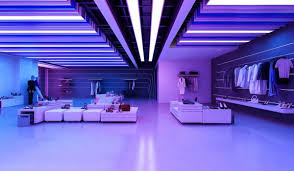Commercial lighting plays a crucial role in the success of any business. The right lighting not only enhances the aesthetic appeal of your space but also influences employee productivity, customer experience, and energy efficiency. Choosing the best commercial lighting for your business needs requires careful consideration of several factors, from the type of lighting to its placement and energy efficiency. In this article, we’ll explore the key aspects you should consider when selecting commercial lighting for your business.
1. Understanding Your Business Needs
Before diving into specific lighting options, it’s essential to understand the unique needs of your business. Different types of businesses require different lighting solutions. For example:
- Retail Stores: Bright, inviting lighting is key to showcasing products and creating an attractive shopping environment. Accent lighting may be used to highlight specific products or areas.
- Offices: Soft, glare-free lighting is crucial for reducing eye strain and creating a comfortable working environment. Task lighting may be needed for workstations.
- Restaurants: Warm, ambient lighting can create a cozy atmosphere that encourages diners to relax and enjoy their meal. Adjustable lighting may be beneficial for different times of the day.
- Warehouses: Bright, uniform lighting is necessary for safety and productivity. High-intensity, energy-efficient lighting is often required for large spaces.
Understanding your specific needs will guide you in choosing the right type of lighting for your business.
2. Types of Commercial Lighting
There are various types of commercial lighting available, each serving a different purpose. Understanding the different types can help you make an informed decision:
- Ambient Lighting: This is the primary source of light in a space and provides overall illumination. It sets the tone of the environment and ensures that the area is well-lit.
- Task Lighting: Task lighting is focused lighting that helps employees or customers perform specific tasks. In offices, this might include desk lamps or under-cabinet lighting, while in retail settings, it could involve lighting display cases.
- Accent Lighting: Accent lighting is used to highlight specific features or areas, such as artwork, architectural details, or product displays. It adds depth and interest to a space.
- Decorative Lighting: While decorative lighting may not contribute much to overall illumination, it plays a significant role in enhancing the aesthetic appeal of a space. Chandeliers, pendant lights, and wall sconces are examples of decorative lighting.
- Emergency Lighting: This type of lighting is essential for safety, providing illumination during power outages or emergencies. It includes exit signs and backup lighting systems.
3. Energy Efficiency
Energy efficiency is a crucial consideration for commercial lighting. Not only does it reduce your business’s environmental footprint, but it also lowers operational costs. LED lighting has become the gold standard in energy-efficient commercial lighting due to its long lifespan and low energy consumption.
- LED Lighting: LED (Light Emitting Diode) lights are highly energy-efficient, using up to 75% less energy than traditional incandescent bulbs and lasting up to 25 times longer. They also produce less heat, which can reduce cooling costs in your facility.
- Energy Star Rating: Look for lighting products with the Energy Star label. This certification ensures that the product meets strict energy efficiency guidelines set by the U.S. Environmental Protection Agency.
- Lighting Controls: Incorporating lighting controls, such as dimmers, timers, and occupancy sensors, can further enhance energy efficiency. These controls allow you to adjust lighting levels based on the time of day or occupancy, reducing unnecessary energy use.
4. Lighting Quality
The quality of lighting is just as important as energy efficiency. Poor-quality lighting can lead to eye strain, headaches, and decreased productivity. When choosing commercial lighting, consider the following factors:
- Color Temperature: Measured in Kelvins (K), color temperature determines the warmth or coolness of the light. Lower temperatures (2700K-3000K) produce a warm, yellowish light, while higher temperatures (5000K-6500K) produce a cool, bluish light. Choose a color temperature that aligns with the purpose of the space. For example, warmer light is suitable for restaurants and lounges, while cooler light is ideal for offices and retail spaces.
- Color Rendering Index (CRI): CRI measures the accuracy with which a light source reveals the colors of objects. A higher CRI (80-100) indicates better color rendering, which is particularly important in settings like retail stores, where accurate color representation can influence purchasing decisions.
- Glare Control: Excessive glare can cause discomfort and reduce visibility. Look for lighting fixtures designed to minimize glare, such as those with diffusers, reflectors, or shielded bulbs.
5. Lighting Layout and Design
The layout and design of your lighting system can significantly impact its effectiveness. Proper placement of lighting fixtures ensures even illumination and enhances the overall aesthetic of the space.
- Layered Lighting: Incorporating multiple layers of lighting—ambient, task, and accent—creates a balanced and versatile lighting scheme. Each layer serves a different function and contributes to the overall atmosphere of the space.
- Spacing and Placement: The spacing and placement of lighting fixtures affect the distribution of light. For example, in an office setting, overhead lighting should be evenly spaced to prevent dark spots or overly bright areas. In retail environments, accent lighting should be strategically placed to highlight key products or displays.
- Lighting Zones: Divide your space into lighting zones based on the activities that take place in each area. For example, in a restaurant, you might have separate zones for dining, the bar area, and the kitchen, each with its own lighting requirements.
- Aesthetics: The design of the lighting fixtures should complement the overall interior design of the space. Whether your business has a modern, industrial, or traditional look, choose fixtures that enhance the visual appeal of your environment.
6. Compliance with Regulations
Compliance with local building codes and regulations is essential when installing commercial lighting. These regulations ensure the safety and functionality of the lighting system.
- Building Codes: Different regions have specific building codes that govern the installation of commercial lighting. These codes may dictate the type of fixtures, the amount of illumination required, and safety standards for emergency lighting.
- ADA Compliance: If your business is open to the public, it must comply with the Americans with Disabilities Act (ADA). This includes ensuring that lighting is accessible to all individuals, including those with visual impairments. For example, wall-mounted fixtures should not protrude more than four inches from the wall to avoid being an obstacle for those with limited vision.
- Environmental Regulations: In some areas, there may be regulations related to light pollution, which can affect the installation of outdoor commercial lighting. Consider using fixtures that minimize light spill and are designed to direct light downward.
7. Maintenance and Longevity
The longevity and ease of maintenance of your lighting system are crucial for minimizing operational disruptions and costs.
- Durability: Choose lighting fixtures made from high-quality, durable materials that can withstand the demands of a commercial environment. For example, in industrial settings, you might need fixtures that are resistant to dust, moisture, or impact.
- Easy Maintenance: Consider how easy it will be to maintain and replace the lighting fixtures. LED lights, for example, require minimal maintenance due to their long lifespan. Additionally, fixtures with easily accessible bulbs or components can reduce the time and cost associated with maintenance.
- Warranty: Check the warranty offered by the manufacturer. A longer warranty period indicates confidence in the product’s durability and can provide peace of mind in case of defects or failures.
Conclusion
Commercial lighting plays a crucial role in influencing employee productivity, enhancing customer experience, and reducing energy costs, thus making it a key decision for your business. By understanding your business needs, exploring different types of lighting, prioritizing energy efficiency and lighting quality, and consulting with a lighting professional, you can create a lighting plan that enhances your space and supports your business goals.
Investing in the right commercial lighting not only illuminates your business but also sets the stage for success. With careful planning and consideration, you can create a well-lit environment that reflects your brand, meets regulatory requirements, and provides a welcoming and productive space for employees and customers alike.




